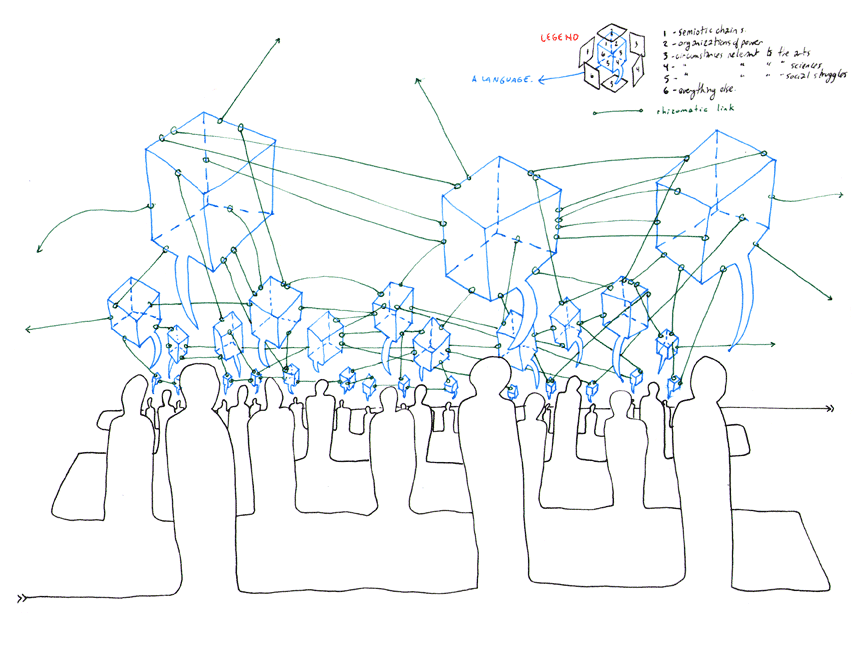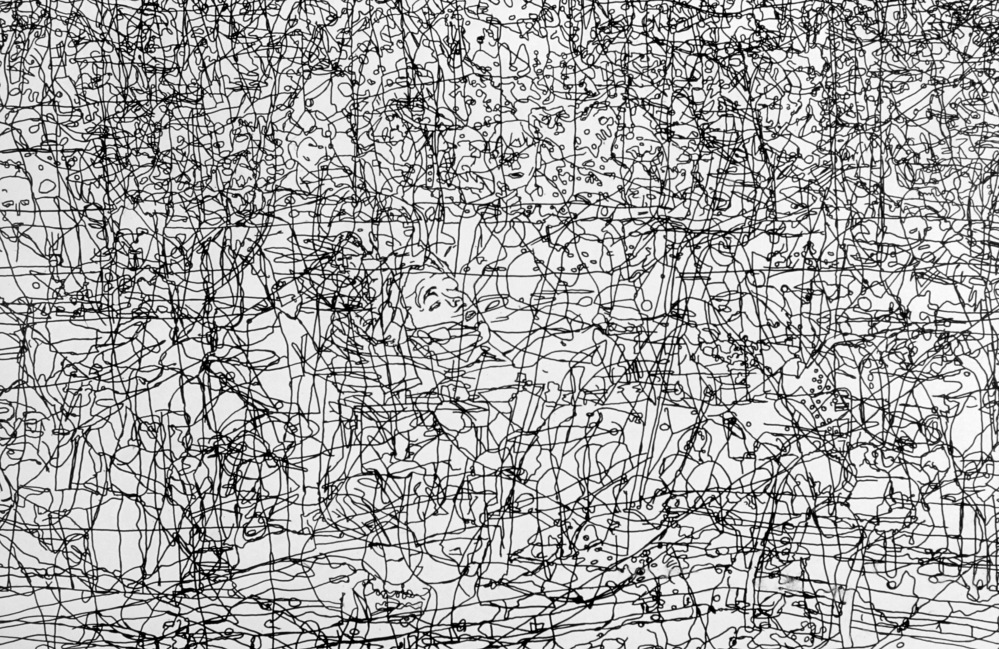Brief Considerations On Recent Events In Oakland
Brief Considerations On Recent Events In Oakland
Given that many people are currently thinking about their direction in the Bay Area, it is an opportune moment to rehash some older ideas and apply them to the current situation in order to move forward.
Encoding and Over-Coding

In their books Anti-Oedipus and A Thousand Plateaus, Gilles Deleuze and Felix Guattari describe the process of encoding and over-coding. We can use these conceptual tools to look more critically at the recent events in Oakland that were responses to the acquittal of George Zimmerman.
Deleuze and Guatarri consider the material world we live in to be an open system that is “permeated by unformed, unstable matters” that constantly flow in every direction. When these matters converge upon a human mind in a coherent form, they are encoded into that mind. The natural and unavoidable act of encoding is the “giving form to matters…of producing upon the body of the earth molecules large and small and organizing them.”
The act of over-coding, on the other hand, is typically a conscious process rather than a natural one. It takes place when the encoding acquired by a subject is overwhelmed by a new code that flows into the mind through physical reality. Capitalism is one of the most massive engines of over-coding. It attempts to subjugate the planet with “phenomena of centering, unification, totalization, integration, hierarchization and finalization.” Put simply, capitalism attempts to over-code a diverse planet into a static and unified whole. However, the capitalists are not the only people who engage in the act of over-coding.
In the city of Oakland, when the crowds damaged property, blocked the freeway, or marched freely wherever they chose, they encoded themselves with the simple knowledge that their bodies were capable of such acts. When someone smashed a window, it encoded the crowd with the simple knowledge that they could smash a window.
By smashing a window or otherwise vandalizing a business or corporate entity, people over-code the established order by tarnishing its surfaces and filling it with signifiers that counteract the effects of capitalist and authoritarian encoding. The police over-code the population with guns and prisons, the banks over-code downtown with their physical existences, Google over-codes San Francisco, and capitalism over-codes life. To over-code our enemy, we must physically change our material reality as quickly as possible while always remaining in flight. Vandalism encodes upon a crowd the knowledge that it is possible to act against the state.
However, acts of vandalism are not the most important acts in the struggle against the global capitalist system. A squatted building encodes an entire neighborhood, and a squatted neighborhood can encode an entire city. There is a vast field of possibility for anti-capitalist subversion within a city like Oakland. In A Thousand Plateaus, the authors write that a force against capitalism must, by its own nature, “destroy the State-form and city form with which it collides.” The authors call this force against capitalism the nomadic war machine. The individuals that constitute it “can make war only on the condition that they simultaneously create something else.”
The extent to which it is successful is determined by the amount of territory it encompasses and its ability to remain un-captured by the State. To create areas free from capitalism and the state is also to defend those areas. The nomadic war machine does not exist to wage war, it exists to continuously compose itself against capitalist encoding and expand the limits of its influence. War is “neither the condition nor the object of the war machine, but necessarily accompanies or completes it.”
The Anarchist Subject

To remain in flight as a nomadic war machine, the state and media apparatus must never be allowed to define and shape the rebel force. After the recent events in Oakland, we have seen the media over-code the anarchist subject. Whenever the typically clad anarchist appears, they are captured, trapped within their own image. The anarchist subject can never be one of the crowd, they can only be themselves, over-coded with significance they cannot escape.
After an anarchist subject hit a waiter in the face with a hammer, the state and media apparatus took this event and used it to over-code the population and provoke a conservative backlash. The actions of one anarchist subject have had repercussions that extend far beyond their (assumed) motivations. By giving the state and media exactly what they want, this anarchist has enabled a very particular and insidious counter-insurgency campaign against the rebel forces. To the larger population, far removed from the rebel force, the anarchist is a static and apathetic figure who uncritically attacks waiters with a hammer and smashes windows.
The anarchist subject encodes a friendly crowd with the knowledge that anarchists exist, appear out of nowhere, and destroy private property. But this encoding, affecting a few thousand people in Oakland, is limited in its goals and has now become repetitive. Beyond this, the anarchist subject has now become a tool used by the state and media to capture rebellion and give it a specific meaning. If the anarchist subject fails to define themselves in an expansive and clear manner, they will always be over-coded by the enemy and their efforts will lead nowhere.
The problem is compounded and magnified when the anarchist subject internalizes the capitalist over-coding assigned to them by the state and media. A few anarchist subjects revel in the image given to them by the enemy, some going so far as to create stickers with a hammer and broken glass on them that champions the attack long after the state and media have ceased to utilize it for their purposes. Capitalist over-coding should never be replicated and prolonged, especially by those who claim to be anarchists.
The Nomadic War Machine of Oakland

What is important for rebel forces in Oakland is to over-code capitalism in a material way. What we do is less important than how we do it. How do we free areas from capitalism? Answering this question takes us on a line of flight that leads us to unexpected places, and most of them do not have any relation to the standard array of anarchist tactics: spray paint, broken windows, fire, rocks, etc.
Deleuze and Guattari believed that the state would often over-code a nomadic war machine and turn it into war. Their belief was shaped by events in Italy during the 1970’s where the Red Brigades and other guerrilla groups were captured by the state and turned into the singular representatives of the massive rebellion. In time they simply became machines of war, fulfilling a dual function as media villains and loyal enemies of the state. Without them, the state repression that descended across the whole of Italy would not have been as simple an affair.
In contrast to the urban guerrillas, the organic rebellions in Milan, Bologna, Rome, and other cities remained nomadic war machines (for a time), using every method available to expand the qualitative scope of their rebellion. They utilized radio, print, fire, love, and paint. They forged alliances whenever possible and pursued every line of flight available to escape capitalism. Their rebellion was diverse and multiform, possessing multiple facets and expressions, all of which were part of the nomadic war machine.
In contrast to the anarchist subject in Oakland, the nomadic war machine must allow itself to grow and not become arrested in stale forms. Anything that increases our ability to live freely and against capitalism should be pursued unless it becomes a hindrance. Events like the hammer attack decrease our power by giving our enemy what it wants. If our enemy wants this hammer to the waiter’s face but doesn’t want another squatted building, it is wiser to squat a building. If our enemy wants us to remain trapped in an insular squatting scene, we must create an expansive and outward focused squatting network that spreads in every direction. This is the line of flight away from control. As Deleuze and Guattari wrote, “fleeing, yes, but while fleeing looking for a weapon.”
A nomadic war machine exists in Oakland and has for several years, although parts of it are now beginning to decay and have ceased to churn and whirr and reach out beyond the imagined limits of the machine. Instead, they have become dead ends that visibly and concretely bolster the state. Anarchism is not a hammer to the face, although that is what the state would have people believe in their efforts to over-code the meaning of our efforts. To be a nomadic war machine, anarchists must dynamically escape the conceptual confines assigned to them by the encoding of the state. If they fulfill the expectations of our enemy, if they complete the narrative set out for them, they are captured.
Rebellion is not measured through quantitative amounts of vandalism, sabotage, or any other particular tactics. Rebellion is without measure. It either appears and strengthens itself, or it is captured and destroyed. Rebellion is not the schemes, visions, or plans of this or that group or vanguard or cadre, it is the boundless energy of the people and what they do to expand that rebellion. All that gives way to freedom, all that expands beyond the confines assigned to it by the state, is the nomadic war machine. The goal should be to expand it, not to control it.
Deleuze and Guattari write, “we certainly would not say that discipline is what defines a war machine: discipline is the characteristic required of armies after the State has appropriated them. The war machine answers to other rules. We are not saying that they are better, of course, only that they animate a fundamental indiscipline of the warrior!”
Indiscipline is everything in the struggle against capitalism, for without it there is no mass auto-reduction of prices, no mass fare dodging, no mass rent strikes, no squatted neighborhoods, and no generalized rebellion. Discipline keeps the economy functioning and capitalism demands discipline from all its subjects. Should any force wish to rebel against capitalism and the state, it will compose itself accordingly, without the need for the discipline of the work place, the school yard, the family, or the police.
Racial Encoding

Hanging over the 580 freeway in Oakland is a billboard with an advertisement for Pepsi. Within the advertisement, the image of Beyonce is replicated four times. In each image she is in a different pose, in each image she has straight blonde hair, and in each image she looks white. This is an example of racial encoding and its effects cannot be quantitatively measured. However, it is clear that this advertisement affects a black person with kinky hair differently than it affects a white person with straight hair.
When a white person destroys the advertisements for straight hair extensions hanging outside a black-owned beauty parlor, they are theoretically acting against this type of racial encoding, but there is a qualitative difference between a black person committing this act and a white person. If the only person to commit such an act is a white person, this certainly indicates that a strong desire to de-code white normativity exists within some white people. However, if a black person commits such an act, it is qualitatively different and will encode the mind of anyone observing with the knowledge that black people, not white people, are in the process of de-coding white normativity.
During recent events in Oakland in reaction the Zimmerman verdict, a white person was the first to vandalize a business. While this may be disputed, it is in fact true. There were many black people visibly and emotionally angry at the first rally in response to the verdict, but none of them were the first to later smash a window.
This truth creates many questions, but the most important one is this: What knowledge did this action encode in the crowd? That white people were just as angry as black people about the verdict? That an easy way to express anger was to break a window? That breaking a window was possible? We do not know the answer, but similar to what was mentioned above, there is a massive and qualitative difference between a white person committing this specific act of vandalism first and a black person committing it.
In conclusion, we would like to say that the actions of various anarchist subjects, whether they hit a waiter in the face with a hammer or broke a café window, over-coded the actions and intentions of the crowds with their specific and rigid conceptions of rebellion. Given that the recent manifestations were in response to the un-avenged murder of a young black man, the reified tactics of the anarchist subject were particularly out of place and limiting in their scope. To end this essay, we will leave you with this quote from Assata Shakur, written in exile:
“Smashing windows will do me no good. I am beyond that. I want blood. The tanks are waiting to crush the resistance, squelch the disturbance. It crosses my mind: I want to win. I don’t want to rebel, I want to win. The revolution will not be televised on the six o’clock news. I have to get myself ready. Revolution. The word has me going.”

For further exploration, read:
This Is Not A ProgramAnd the kinds of actions Assata prefers have historically been proceeded by the kinds the black bloc practices: throwing rocks at cops in Birmingham, and vandalizing businesses in Cambridge Maryland in 1963 -
http://teachingamericanhistorymd.net/000001/000000/000033/html/t33.html
Get Involved
If you'd like to help with maintaining or developing the website, contact us.
Publish
Publish your stories and upcoming events on Indybay.


